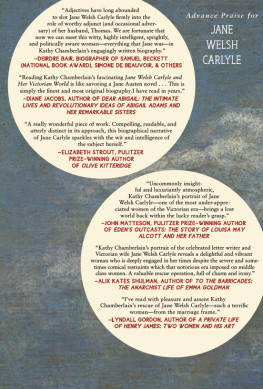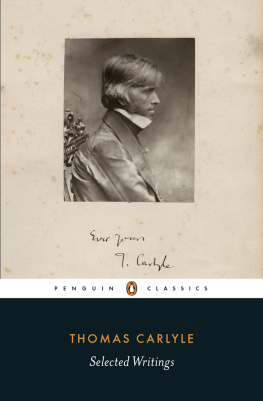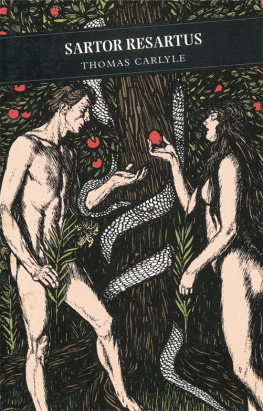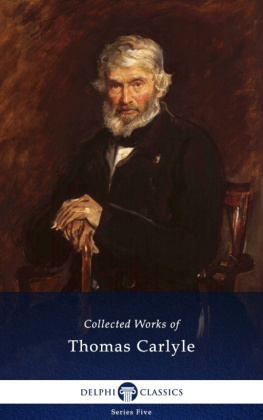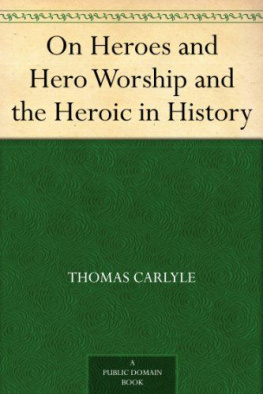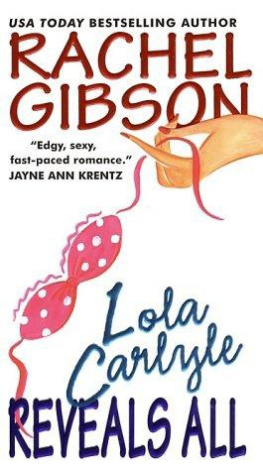This edition first published in hardcover in the United States and the United Kingdom in 2017 by Overlook Duckworth, Peter Mayer Publishers, Inc.
N EW Y ORK
141 Wooster Street
New York, NY 10012
www.overlookpress.com
For bulk and special sales, please contact ,
or write us at the above address
L ONDON
30 Calvin Street
London E1 6NW
www.ducknet.co.uk
Copyright 2017 by Kathy Chamberlain
All rights reserved. No part of this publication may be reproduced or transmitted in any form or by any means, electronic or mechanical, including photocopy, recording, or any information storage and retrieval system now known or to be invented, without permission in writing from the publisher, except by a reviewer who wishes to quote brief passages in connection with a review written for inclusion in a magazine, newspaper, or broadcast.
ISBN: 978-1-4683-1421-2
KATHY CHAMBERLAIN
JANE WELSH CARLYLE
AND HER VICTORIAN WORLD
A Story of Love, Work,
Friendship, and Marriage
With 14 color and 13 black-and-white images
H ailed by Virginia Woolf as one of the all-time great letter writers, Jane Welsh Carlyle, wife of Victorian literary celebrity Thomas Carlyle, has been much overlooked. In this compelling new biographya delightful book about the early stirrings of feminism in Victorian England and a celebration of the lost art of letter writing (Kirkus)Kathy Chamberlain brings Jane out of her husbands shadow, focusing on Carlyle as a remarkable woman and writer in her own right.
Caught between her own literary aspirations and Victorian societys oppression of women, Jane Welsh Carlyle, while respecting the housewifely sphere, yearned to discover a mission in life beyond it. As she and her husband moved in exclusive London literary circles, mingling with noted authors, poets, and European revolutionaries, Carlyle created and reported to her correspondents on her rich, rewarding life in her Chelsea homeuntil her husbands infatuation with a wealthy, imposing aristocratic society hostess threw her life into jeopardy.
Through dedicated research and unparalleled access to Jane Welsh Carlyles private correspondence, only recently fully available, Kathy Chamberlain presents an elegant portrait of an extraordinary, unsung writer, as well as of the era.

The Carlyles in their ground-floor parlor, detail from A Chelsea Interior by Robert Scott Tait, 1857.
This book is lovingly dedicated to the following people
without whom it would not have happened:
Michael Zweig, Elizabeth Strout, Marcia and
Marlin Brenner, and Aileen Christianson


I S IT POSSIBLE TO PART THE CURTAINS, LOOK BACK THROUGH THE CENTURIES and discover the aliveness of a Victorian woman? Can she be glimpsed from fresh points of view, rather than through the sentimental scrims of her time?
Jane Welsh Carlyle (1801-1866) became, as Virginia Woolf put it, one of the great letter-writers. Her letters, always entertaining, can be funny enough to make a reader laugh out loud. Yet more than her epistolary brilliance has prompted Jane Welsh Carlyle and Her Victorian World, a story set in London during the 1840s, one of the most vibrant, turbulent decades of the nineteenth century, a time rife with controversy and change; in some uncanny ways, a time not unlike our own.
Born and raised in Scotland in the prosperous town of Haddington, near Edinburgh, Jane Baillie Welsh received a good education for a girl of her era, in schoolrooms and from private tutors. Her father was a doctor, and her motherfrom a respectable well-to-do backgroundmanaged the household. Her parents counseled their only child as to her path in life, yet could never have predicted the surprising turns it would take.
Thomas Carlyle (1795-1881) was Scottish also, but born into a different social class: an extended family of stonemasons, peasant farmers, and domestic servants in the poorer, more out-of-the-way village of Ecclefechan. Unlike Jane, he had brothers and sisters with whom he was united in a network of kinship. Showing great intellectual gifts early on, Thomas studied at the University of Edinburgh where he befriended Edward Irving (later a notorious, controversial minister), who happened to be Janes tutor. Edward was very fond of Jane, but he was engaged to another. He introduced her to Thomas, who eventually took Edwards place as Janes mentor and began advising her on books to read and critiquing pieces she wrote, a relationship that evolved into a courtship.
In 1826, five years after they had met, Jane and Thomas married. After a brief residence in Edinburgh, they spent half a dozen years living on a hardscrabble farm of austere beauty, Craigenputtoch. Left to Jane by her father, the farm was (and is) located in an isolated section of southwest Scotland. With his brother Alexander helping to manage the farm, Thomas labored at turning himself into an author, and Jane learned to be a hardworking housewife. Although large families were then the norm, the Carlyles were not to have children. In 1834, to further Thomass literary career, which was now showing promise and possibility, they rented out the farm and moved to the Chelsea section of London. There they would remain, and there Jane would write some of her most dazzling letters. Their well-preserved home on Cheyne Row is open to the public and can be visited today.
Known for her witty conversation and sense of fun, Jane Carlyle encouraged a romantic, humorous family legend that she was descended from John Knox, leader of the Scottish Reformation and founder of Presbyterianism, and, along a separate line, from a gypsy: a cross betwixt John Knox and a Gipsey how that explained all. The combination underscored her Scottishness and could be used to account for her contradictions: her black hair; long-lashed dark, almost black eyes; and neat modest style of dress; her excitable interest in personalities and issues of her dayoften with a forlorn wae or woeful strain woven throughand an underlying firmness to her character.
Though celebrity then was not the circus it has become in our era, Jane Carlyles husband, after establishing himself as an author, came to be one of the most famous literary men in the British Isles, as well as in Europe and America. Known as the Sage of Chelsea, Thomas Carlyle authored books profoundly inspiring to his generation, especially his spiritual autobiography Sartor Resartus (1833-4) and his epic, poetic history The French Revolution (1837). In 1855, when many readers had grown weary of the increasingly reactionary opinions that Thomas favored as he aged, George Eliot testified to the enduring strength of his reputation: [T]here is hardly a superior or active mind of this generation that has not been modified by Carlyles writings; there has hardly been an English book written for the last ten or twelve years that would not have been different if Carlyle had not lived.
For several sparkling years of the 1840s, Jane Carlyle was immersed in issues and controversies of her day, such as the British governments prying into the mail of private individuals; the treatment of the mentally ill; and the craze for mesmerism, or hypnotism, that swept through Victorian England. Because of her husbands fame and the fact of their dwelling in London, Jane met a range of outstanding Victorians, men and women whose lives and works matter to us today.

